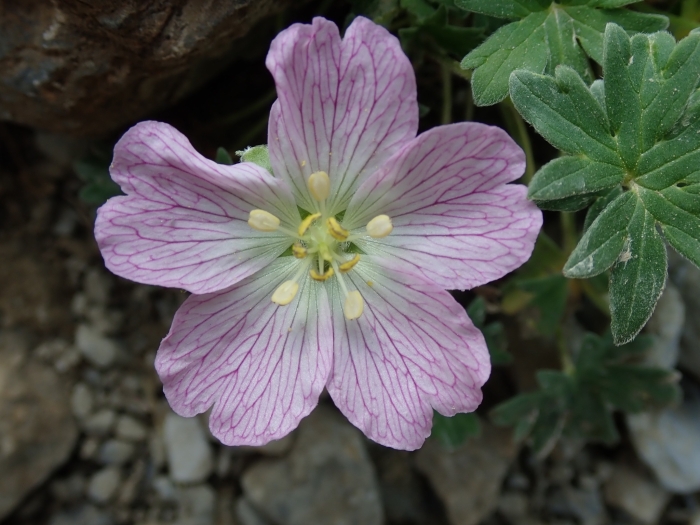Ashy Cranesbill
(Geranium cinereum)
Ashy Cranesbill (Geranium cinereum)
/
/

bigayon
CC BY 4.0
Image By:
bigayon
Recorded By:
Copyright:
CC BY 4.0
Copyright Notice:
Photo by: bigayon | License Type: CC BY 4.0 | License URL: http://creativecommons.org/licenses/by/4.0/ | Rights Holder: bigayon | Publisher: iNaturalist | Date Created: 2021-08-23T16:17:11-07:00 |


























Estimated Native Range
Summary
Geranium cinereum, commonly known as Ashy Cranesbill, is a low-growing perennial herb native to the mountainous regions of the Pyrenees. It typically reaches up to 6 inches (15 cm) in height, with a spread of up to 20 inches (50 cm). This plant is characterized by its compact growth habit, lobed grey-green leaves, and cup-shaped, violet-pink flowers with distinctive dark purple-black centers, which bloom from late spring to early summer. The flowers are quite showy and attract pollinators such as bees.
Ashy Cranesbill is appreciated for its ornamental value, particularly its attractive foliage and long-lasting, vibrant flowers. It is an excellent choice for ground cover, rock gardens, and alpine plantings. It has been awarded the Royal Horticultural Society’s Award of Garden Merit, indicating its exceptional performance in gardens. In cultivation, it requires well-drained soil, preferably with a gravelly or sandy texture, and thrives in full sun to part shade. While it is hardy to -15°C, it benefits from a mulch layer in colder climates to protect the roots. Regular deadheading can encourage a longer flowering period. It is generally disease-resistant but can be affected by rust or mildew in humid conditions. Overwatering should be avoided to prevent root rot.CC BY-SA 4.0
Ashy Cranesbill is appreciated for its ornamental value, particularly its attractive foliage and long-lasting, vibrant flowers. It is an excellent choice for ground cover, rock gardens, and alpine plantings. It has been awarded the Royal Horticultural Society’s Award of Garden Merit, indicating its exceptional performance in gardens. In cultivation, it requires well-drained soil, preferably with a gravelly or sandy texture, and thrives in full sun to part shade. While it is hardy to -15°C, it benefits from a mulch layer in colder climates to protect the roots. Regular deadheading can encourage a longer flowering period. It is generally disease-resistant but can be affected by rust or mildew in humid conditions. Overwatering should be avoided to prevent root rot.CC BY-SA 4.0
Plant Description
- Plant Type: Herb
- Height: 0.8-1 feet
- Width: 1-1.5 feet
- Growth Rate: Moderate
- Flower Color: Pink, Purple
- Flowering Season: Summer
- Leaf Retention: Deciduous
Growth Requirements
- Sun: Full Sun, Part Shade
- Water: Medium
- Drainage: Fast, Medium
Common Uses
Bee Garden, Border Plant, Butterfly Garden, Groundcover, Low Maintenance, Potted Plant, Rock Garden, Street Planting
Natural Habitat
Mountainous regions of the Pyrenees
Other Names
Common Names: Grayleaf Cranesbill
Scientific Names: Geranium cinereum , Geranium argenteum subsp. cinereum , Geranium cineraceum , Geranium cinereum subsp. cinereum , Geranium cinereum var. typicum , Geranium varium
GBIF Accepted Name: